| HOME | RESEARCH | PEOPLE | FIELD WORK & PHOTOS | BLOG | COURSES | LINKS |
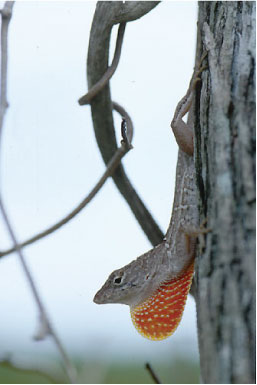
Displaying brown anole (Anolis sagrei) photographed in Cuba.
>Research Overview
>Projects
>Lab & Field Studies
>Anolis Lizards
>Publications
>Protocols & Data
|
Research Projects |
| Stages of Adaptive Radiation | |
| The notion that evolution is sometimes predictable has gained support in recent years. In some cases, it has been suggested that adaptive radiatitons progress through a predictable series of stages, involving specialization along distinctly different resource axes. We are testing whether any such general patterns are applicable to the anole radiation, which has undergone at least two stages of radiation (microhabitat and macrohabitat). This study involves a comprehensive comparative analysis based on new phylogenetic analyses of mitochondrial and nuclear DNA sequence data. Analyses of this phylogeny are being implemented using the latest software and methods new to this study. | |
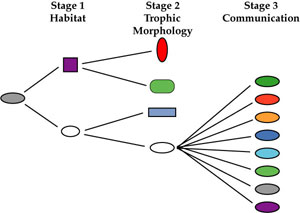 |
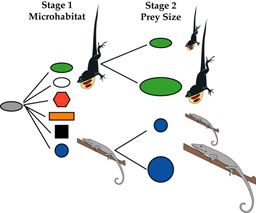 |
| General stages of vertebrate radiation hypothesized by Streelman and Danley (TREE, 2003). Radiation begins with divergence in habitat. In the case of African cichlids, this involves occupation of sandy or rocky substrates. The second stage in cichlids and other groups involves specialization to different food types. Finally, divergence in communication results the ecologically and morphologically similar species that differ traits important to sexual selection and signaling such as color and pattern. | Pattern of anole radiation discussed by Losos 1996 and adopted by Streelman and Danley 2003. It is hypothesized that divergence to different types of micohabitats (e.g., trunk, crown, grass), preceded divergence in body size, which corresponds to specialization on different prey. We are testing this pattern against alternative scenarios suggested by other aspects of the anole radiation. |
| The Nature of Replicate Radiation | |
| The anole radiation is well-known as an example of replicate adaptive differentiation, with similar sets of micohabitat specialists, or ecomorphs, having evolved independently on several islands. Unfortunately, the extact sequence of ecomorph specialization, and the mechanisms that contributed to their divergence, are clouded by their deep evolutionary history. In an effort to examine the finer points of replication in the anole radiation (i.e., sequence and mechanism), I am carrying out studies of divergence within ecomorphs. In many cases intra-ecomorph/intra-island radiation have diverged along remarkably similar secondary axes such as macrohabitat. Phylogenetic studies indicate that radiations of trunk-crown and trunk-ground anoles occurring on Greater Antillean islands often share remarkably similar patterns of macrohabitat specialization and speciation mechanisms. This work has been completed for the Hispaniolan trunk-ground radiation and the Cuban trunk-crown radiation. I'm currently wrapping up comparative projects with Cuban trunk-ground species and Hispaniola trunk-crown species. | |
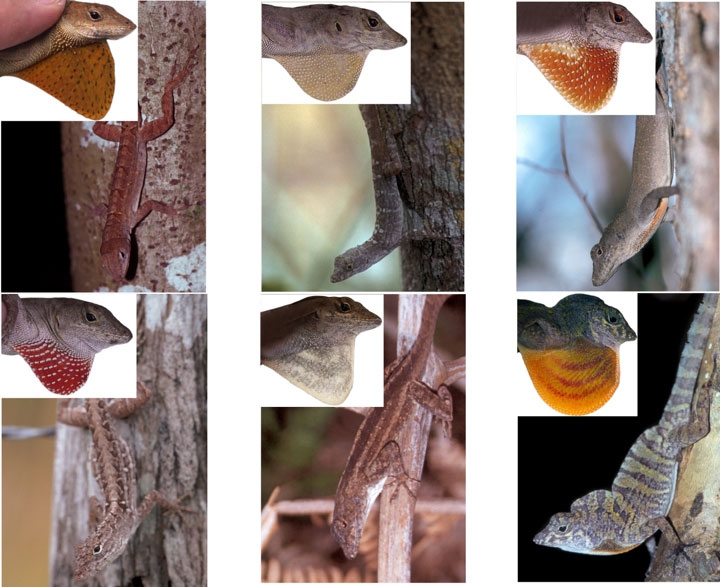 |
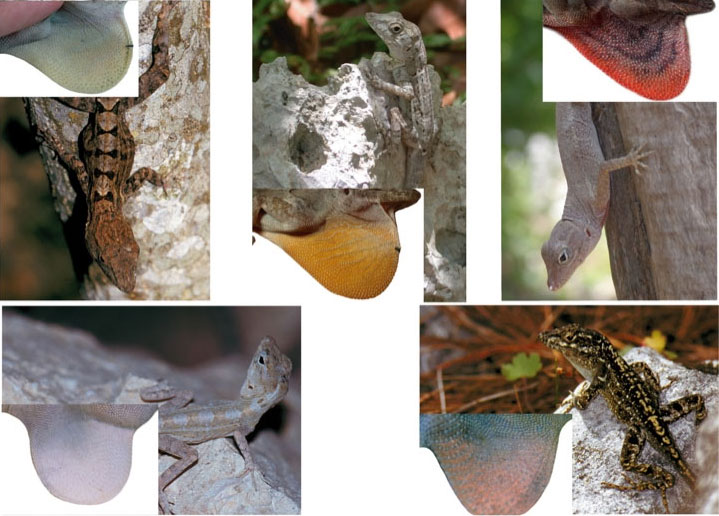 |
| Cuban trunk-ground anoles belonging to the sagrei species group (clock-wise from top left): Anolis bremeri, A. guafe, A. jubar, A. rubribarbus, A. homolechis, A. sagrei (copyright R. Glor). | Hispaniolan trunk-ground anoles belonging to the cybotes species group (clock-wise from top left): Anolis cybotes, A. longitibialis, A. marcanoi, A. armouri, A. whitemani (copyright R. Glor). |
| Ecological Speciation | |
| The anole dewlap, or throatfan, plays an important role in intra-specific communication, and has long been considered critical to species recognition. As such, it likely plays a role in anole speciation and may even contribute to the group's extraordinarily high species richness. Recent work indicates that variation in dewlap color and pattern is driven by environmental variation, with dewlaps adapting to optimize their signaling efficiency under a given set of environmental light conditions. This linkage between environmental and phenotypic variation (of a trait important to species recognition) may result in speciation across environmental gradients. In collaboration with Manuel Leal at Vanderbilt University, I am investigating this possibility in two polymorphic anole species: the Puerto Rican crested anole (Anolis cristatellus) and the Hispaniolan trunk anole (Anolis distichus). Thusfar, molecular work with mtDNA, nuclear DNA and microsatellites has revealed a complex picture of population differentiation. In the summer of 2005, we began field work on Anolis distichus. Once at the University of Rochester, this work will take advantage of the lizard room to explore the value of breeding experiments to this work. | |
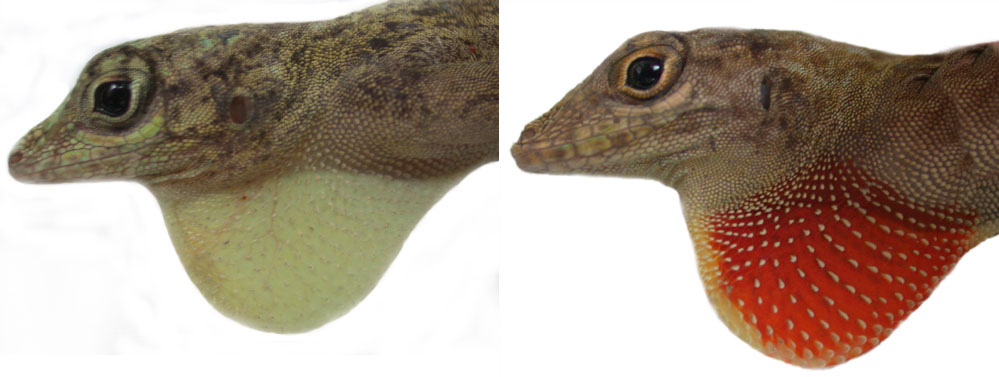 |
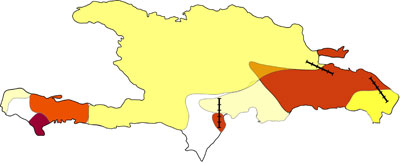 |
| Headshots of Hispaniolan trunk anoles (Anolis distichus) from two localities in the Dominican Republic showing the highly polymorphic nature of the dewlap in this species (copyright R. Glor). | Map of Hispaniola with shaded regions reflecting the color of Anolis distichus dewlaps in that region. Black bars indicated transects being investigated by our study. |
| Diversification of Australian Agamid Lizards | |
| In collaboration with Jane Melville (Museum Victoria) and Jim Schulte (Clarkson University) I am studying the evolution of Australia's diverse lizard fauna. Our work ranges from basic taxonomic revisions to sophisiticated analyses of species diversification and speciation mechanisms. My work on this project will focus in particular on the taxonomically problematic members of the genus Pogona (bearded dragons). | |
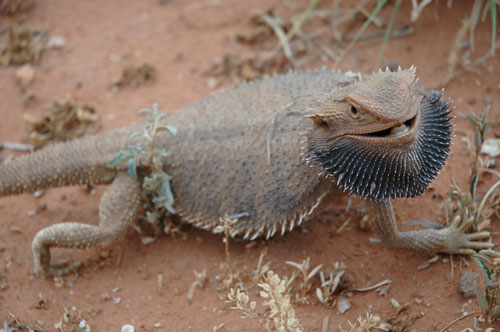 |
Pogona vitticeps from central Australia (copyright R. Glor). |
| Biological Diversification Across the West Indian Archipelago | |
| I am broadly interested in the evolution of biological diversity on island archipelagos, and the West Indies in particular. In an effort to advance our understanding of evolution in this region, Jonathan Losos, Bob Ricklefs, and I have organized a 'Catalysis' meeting with sponsorship from the National Evolutionary Synthesis Center (NESCent). This meeting will bring together a diverse set of scientists, including biogeographers, population geneticists, paleontologists, and geologists. The meeting will be held in the summer of 2006 at the Punta Cana Resort in the Dominican Republic. Due to budget and venue, attendence is limited to invitees. However, this may represent the first step in a larger effort, so please drop me a line if this topic is of interest. | |
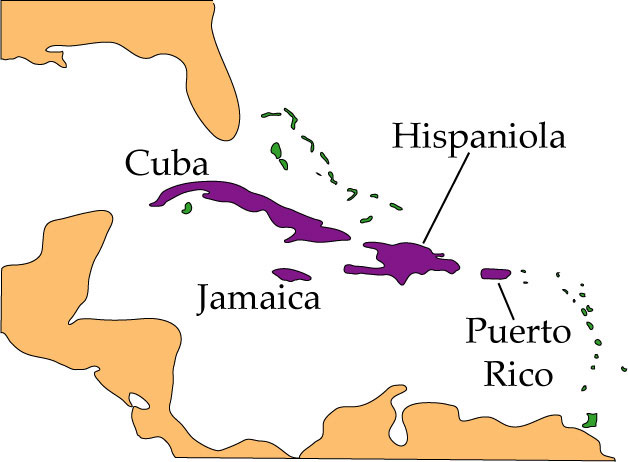 |
The West Indian archipelago |